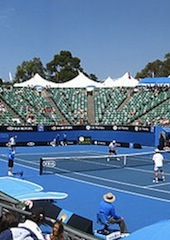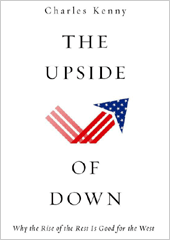Australia and China’s New Goddess in White
Tennis anyone? The economics of the Australian Open in the Asian Century.
January 31, 2014

Li Na’s hard fought victory in the Women’s final of the Australian Open was received in Australia right on the cusp of the Chinese New Year celebrations. World, take note: the latter are getting bigger and better each year in Australia.
In fact, short of cheering on an Australian champion, Li Na had become “the people’s choice” (and the People’s Republic’s choice). Many Australians had taken the 31-year-old to their hearts in her third attempt to win the Australian Open. Never mind that her unique public speaking style made her a crowd favorite and social media sensation, well beyond her tennis skills and fighting spirit.
In some ways, Li Na’s January 2014 win was the first win in the Australian Open for the Asian Century, not just in terms of Li Na’s Chinese nationality, but also economically speaking.
I couldn’t help noticing that the advertising billboards were all of major Australian brands that are emerging as major brands in China (such as ANZ and Jacobs Creek). In fact, the Jacobs Creek billboard – an Australian wine company headquartered in Rowland Flat near Adelaide – was in Mandarin.
The company was appealing directly to the burgeoning middle class in China, which is always looking for great Australian red. Unlike golf, which is under some ideological suspicion and is labeled as “green opium” by some in China, tennis is a middle class game and considered aspirational.
From Australia, with love
The appeal to middle class audiences in Asia – particularly in China and India – is part of the global strategy of Tennis Australia to build the game globally.
According to Robin O’Neill of Tennis Australia, “China and India are growth markets in Asia for Australian Tennis, along with our strategy to grow the grass roots in the suburbs and regional Australian as well.”
He’s right. The audience numbers tell the story. While almost 700,000 people visited Melbourne for the Australian Open, there was a massive global television audience of 300 million. The tournament, a “nightmare” for American viewers time zone wise, runs in convenient time zones for Asia (especially for Li Na’s vast cheering squad in China).
And as O’Neill explains it, “We may not have Aussie stars winning the Open like we did in Australian tennis’s heyday in the 1950s and 1960s, but we can invest in the stars of the future.”
Even without Aussies winning the event, the value of the Australian Open to the country’s economy is significant. Not the least of it is – hope springs eternal! – that it underwrites investment in future Australian tennis talent.
The Government of Victoria estimates that the 2013 Australian Open injected $238 million into the local economy. No wonder Melbourne, Australia’s sports capital is fighting hard against efforts to move the event to Sydney.
But back to the tennis itself. It’s been a while since Australia has had a big-time Australian champion – male or female. Times when the names Laver, Newcombe, Rosewall, Court and Goolagong-Cawley were on the lips of not just every Australian household, but of tennis fans worldwide are a faint memory by now.
Perhaps, in these multicultural times, in the Asian Century, given Tennis Australia’s commitment to the region as well as at home, we might see a Chinese Australian winner in 10 or 20 years’ time? But for time being, we can all cheer for Li Na!
The author thanks Robin O’Neill of Tennis Australia for his assistance.
Takeaways
The Chinese New Year celebrations are getting bigger and better each year in Australia.
Major Australian brands are emerging as major brands in China.
The advertising billboards at the Australian Open were directed at China’s middle class – in Chinese!
The appeal to Asian audiences, particularly in China and India, is part of the global strategy of Tennis Australia.
Many Australians have taken the 31-year-old Li Na to their hearts.
Read previous

How the US Was Smarter Than the UK
January 31, 2014
